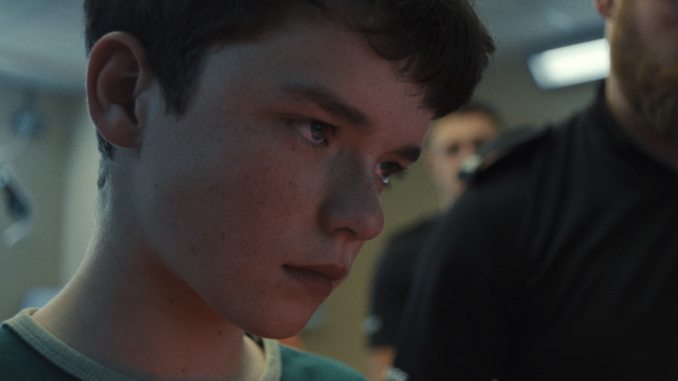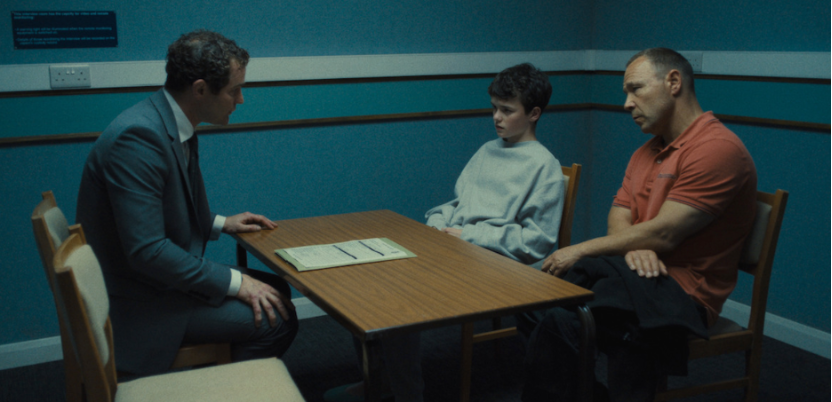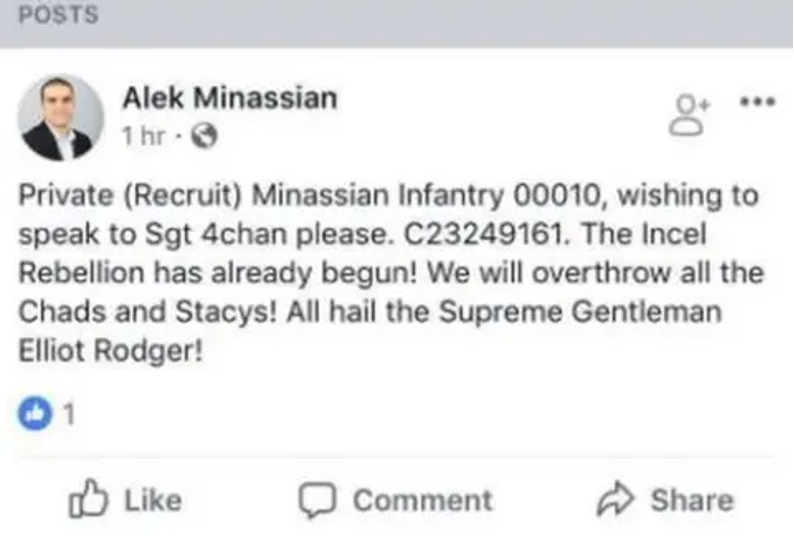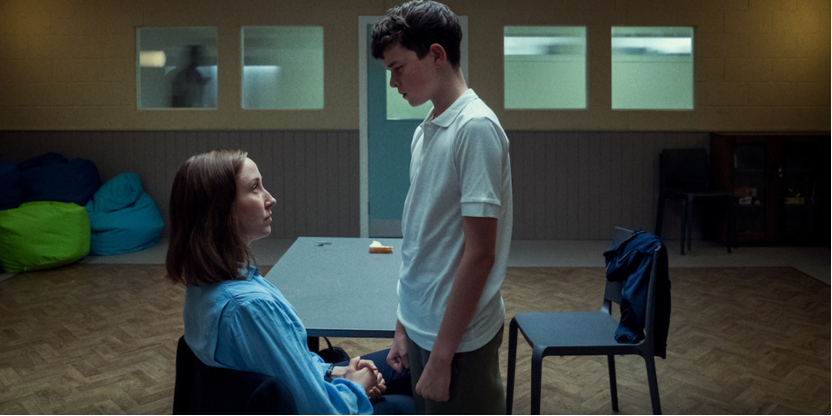
Introduction
As Adolescence, a popular Netflix series was recently seen in high ratings, BBC journalists Ian Youngs and Lizo Mzimba reported on March 25, 2025, that “Adolescence” became the first streaming series to top the weekly TV ratings in the UK. According to ratings agency Barb, the first episode of “Adolescence” was viewed by 6.45 million people in its first week. In addition to the one-shot shooting technique and the mature and exquisite acting skills of the young actors, the words misogyny, masculinity, incel and other related topics have been discussed by the audience.

The story follows Jamie, a 13-year-old boy who is well-behaved and introverted in the eyes of his parents, who is accused of murdering a girl in his class. Just when the audience and Jamie’s parents in the drama, think that there is something else, waiting for the case to turn around, the police come up with the surveillance video that records the whole process of Jamie killing a classmate.
This is not just a fictional plot.
In 2018, a deliberate truck crash in Toronto killed 11 people, nine of them women. This is the first time such a case has been defined as a terrorism crime (BBC News, 2023a). In a Facebook post just minutes before the attack, the driver, Alek Minassian, used cryptic language expressing his desire to attack on behalf of the “Incel” community, paying tribute to the so-called “Supreme Gentleman” Elliot Rodger. (BBC News, 2018a).

Elliot Rodger, who was honoured by Alek Minassian, went on a stabbing and shooting rampage in California in 2014 that left six people dead. YouTube videos and autobiographical documents he posted before his suicide were filled with hatred and accusations from women. He packaged his crime as justice and thus became a “martyr” worshipped by the Incel community. Followers have venerated him, blaming the trigger of the tragedy on the women’s sexual imperfection, and have made videos and T-shirts in their vanguard’s eternal memory (BBC News, 2018b).
It follows that a large community is active behind such cases, sharing their hate speech against women, providing mutual recognition, and even rationalizing and heroizing the diabolical act of murder. Killing is the punishment for refusing to fall in love with me.
These are the facts revealed by Adolescence. In the show, Jamie refuses to confess to the brutal murder of his classmate Katie, months after his arrest, even though the whole process is caught on camera. In his conversations with counsellors, he expressed more confusion than regret. He doesn’t understand why Katie still refuses to accept him, even as the nude photo of her goes viral. He does not pity Katie’s suffering, he cares about whether Katie’s chest is a little flat for him, and whether he can take advantage of this humiliation and violence. He said: “The person who posted her picture was stupid because no more girls will like him.”
The hatred nurtured by the platform.
Social platforms amplify hate, and algorithms encapsulate it. Jamie wasn’t born cold, and Jamie’s parents didn’t let him. His violence is not rooted in his family, but in the “common sense” constructed by the information contained in tweets, likes and comments on social platforms. The “ridicule” of women’s bodies seen everywhere on social platforms is to subconsciously inform teenagers that discrimination and objectification of women are “acquiesced” by society.
Compared with this kind of invisible discrimination against gender, what is more frightening is the platform algorithm’s strong push of obviously misogynistic content. According to a report released by the Association of Head Teachers in the UK, after five days of use of TikTok, the amount of misogynistic content quadrupled on the For You page; The content is targeted at young users. For boys who have anxiety or are experiencing bullying, misogyny can easily be internalized into a “worldview” that points the finger at women. Therefore, sexism and misogyny are normalized by algorithms and infiltrate into young people’s lives and campuses (Regehr et al., 2023). Algorithms ignore toxicity and pursue “topics” and “hot spots”; And the more toxic, the hotter the topic.
Reddit is even more extreme. In The event “The Fappening”, Reddit pushed many illegally distributed private photos of female celebrities to the front page to gain topic and click rate (Massanari, 2017). The platform’s condoning of a culture of misogyny and gender-based violence cannot simply be defined as a misstep. In a society where patriarchal power dominates the discourse, the so-called “neutrality” maintained by the platform is a structural oppression of the female group.
This trend is also confirmed by social psychology research. In a study of adolescents, Wachs et al. (2022) found that witnessing hate speech was positively associated with committing hate acts among young people. This means that when hate speech is read, the seeds of violent crime are planted. And when there is no clear opposition in the social environment, there is only one opportunity to imitate hate speech to carry out specific acts.
Social platforms and algorithms are becoming petri dishes that feed the virus of teenage male extremism: finding audiences for hate and providing resonance for emotions. What is more difficult to guard against than explicit attack content are the terms or symbols with different connotations.
Encrypted calls in social media

In the Adolescence episode, the police try to understand Jamie’s motives for killing through his social media and social connections. After a fruitless investigation, his son, also a junior high school student, revealed the mystery to him. All seemingly benign interactions on Jamie’s social media accounts can be mercilessly sarcastic and bullying: “Red dynamite says: I see the world as it is… It was a call to action from the men’s circle.” “Red heart means love; Purple, horny; Yellow, I’m interested; Pink, I’m interested, but not in sex; Orange, you’re gonna be fine ……” These seemingly ordinary interactions constitute a set of expression systems that are not easily understood by adults and platforms.
This “code word” was not formed by accident; it was consciously created to evade regulation. With the gradual strengthening of platform supervision mechanisms, hate expression on social platforms has become more and more “hidden” and “symbolic”. Even verbal abuse is no longer straightforward, but conveys emotion and meaning through abbreviations, colours, expressions, etc. Behind the surface friendly language is full of hostility and attack. This kind of fuzzy semantic transmission has greatly increased the difficulty of platform supervision.
Under different cultural backgrounds, different languages have the function of natural fuzzy semantics. The current model Facebook uses to monitor hate speech only supports more than 40 languages and is largely blind to local context and cultural connotations. At the same time, human auditors around the world often consult audit standard documents with translation software and non-native English speakers’ understanding of audit content cannot be guaranteed (Sinpeng et al., 2021). Loopholes in the way it is moderated have allowed a lot of hate speech to be exploited, and Facebook’s ability to identify misogynistic speech is much lower than its ability to identify racial discrimination, which will result in a lot of misogynistic hate speech remaining on the platform.
Teenagers are at a stage where their discernment ability is not perfect and they are on a social platform where hate speech can be easily reached, and they are easily affected by the extreme and inflammatory nature of such speech, deviating from the normal and healthy ideological development track. As Jamie’s father said before the finale, he couldn’t guarantee what his child was consuming daily, and he thought he was safe in the room. However, the door of the room cannot isolate the algorithm, and every dead corner that cannot be monitored on the platform is an opportunity for poisoning teenagers.
Masculinity discipline in society
Jamie’s reasons for breaking down and killing people are complex and varied. Beyond the hatred, what was more evident in him was a sense of loneliness, a lack of self-identity, and an anxiety about the lack of “manhood.” In the third episode of the series, he talks to a psychologist, showing a strong sense of inferiority and insecurity. He said that according to the 80/20 rule, 80% of women’s resources are in the hands of 20% of men. Thin, average, and not good at sports, he naturally fit into the remaining 80% of men.
What Jamie considers a successful man may have a template, and the template is described by the surrounding culture and family. His father was a typical manual labourer, and manual work was also a symbol of traditional masculinity. His father never expressed disappointment in him, but his father would guide Jamie through different sports – deliberately looking away when Jamie was playing goalkeeper but couldn’t catch the ball in a game. His father’s attempt to hide his disappointment was quickly picked up by the sensitive Jamie.

Jamie has low self-esteem. He admits it. But when this inferiority complex was exposed in front of the female psychologist, he displayed a state of rage. The psychologist responded with silence to Jamie’s comments about his appearance. But it was this “no refutation” silence that stung him deeply. In his view, this is a tacit acknowledgment that you are a failure. Even though he has verbally classified himself as a “bottom man”, he still cannot accept the disregard from women, which makes him rely on self-deprecating pretence to be pierced.
Jamie is not an individual, but a group. Many male teenagers grow up being taught to “man up” and solve problems. Connell and Messerschmidt (2005) call this discipline “hegemonic masculinity”. There is no clear definition of what it means to be a man, and boys can only imitate the most superficial and narrow “masculinity” in society and the media, these superficial “masculinities” are often mistakenly equated with rudeness, violence, control, etc. These male teenagers who have been disciplined are often deprived of the right to have gentle, sensitive, emotional expression and other characteristics in their growth.
When society widely rewards people with “manly” temperament, giving them subjectivity, the opposite side, “feminine temperament”, will be repressed as an object. This structural logic not only excludes multiple gender characteristics but also subconsciously nourishes malicious feelings toward women.
Reflection
Not every teenager exposed to misogynistic speech will become Jamie, but every child surrounded by hate speech and left without guidance can be on a path of no return. Misogyny reflects the structural problem of misogyny, which is not a single platform, social or family education problem, and multiple parties need to be held accountable for underage murderers. However, shared responsibility does not mean that a single effort can be ignored. On the contrary, the system can only be shaken if every node starts to act.
While action can be carried out, it is the awareness that is difficult. The real question is: Is misogyny perceived? Is misogyny recognized as a real crisis that needs to be addressed immediately? Can platforms put away the shield of free speech and admit that hateful content poses a threat to social security? Can society and the family face up to gender differences and give up the brainless praise of “manly” temperament?
Thankfully, reality has been echoed. According to The Times, as Adolescence was widely discussed in the United Kingdom, British schools will crack down on incel groups and begin educating boys through anti-misogyny programs (The Times, 2024). This shows that the film and television drama can affect the important significance of society.
References
BBC News. (2018a, April 24). Toronto van attack: Facebook post may link suspect to misogynist ‘incel’ movement. https://www.bbc.com/news/blogs-trending-43881931
BBC News. (2018b, April 26). Isla Vista killings: How misogynist killer became ‘incel hero’. https://www.bbc.com/news/world-us-canada-43892189
BBC News. (2023a, June 20). Toronto van attacker sentenced to life in prison without parole. https://www.bbc.com/news/world-us-canada-65829240
Massanari, A. (2017). #Gamergate and The Fappening: How Reddit’s algorithm, governance, and culture support toxic technocultures. New Media & Society, 19(3), 329–346. https://doi.org/10.1177/1461444815608807
Netflix. (2025). Adolescence [Photo gallery]. Netflix Tudum. https://www.netflix.com/tudum/galleries/new-gallery-2zyiubjyluljhjw04bsnlp?mediaIndex=15
Regehr, C., Geoffrion, S., Dinisman, T., & Trocmé, N. (2023). Safer scrolling: Responding to online misogyny and algorithmic harm to youth. Association of School and College Leaders (ASCL). https://www.ascl.org.uk/ASCL/media/ASCL/Help%20and%20advice/Inclusion/Safer-scrolling.pdf
Sinpeng, A., Martin, F., Gelber, K., & Shields, K. (2021). Facebook: Regulating hate speech in the Asia Pacific. University of Sydney & University of Queensland. https://r2pasiapacific.org/files/7099/2021_Facebook_hate_speech_Asia_report.pdf
Wachs, S., Willems, A. S., Vazsonyi, A. T., & Wright, M. F. (2022). Associations between witnessing online hate and perpetrating cyberhate among adolescents: The moderating role of moral disengagement. Journal of Interpersonal Violence, 37(5–6), NP3111–NP3134. https://doi.org/10.1177/08862605211056032
The Times. (2024, April 1). Schoolchildren to be taught about incel misogyny after TV drama Adolescence sparks debate. https://www.thetimes.com/uk/society/article/school-children-lessons-misogyny-adolescence-r6qpdjq7d

Be the first to comment